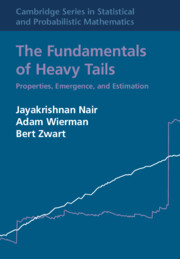Refine search
Actions for selected content:
2703 results in General statistics and probability
Commonly Used Notation
-
- Book:
- The Fundamentals of Heavy Tails
- Published online:
- 17 May 2022
- Print publication:
- 09 June 2022, pp 238-239
-
- Chapter
- Export citation
5 - Additive Processes
- from Part II - Emergence
-
- Book:
- The Fundamentals of Heavy Tails
- Published online:
- 17 May 2022
- Print publication:
- 09 June 2022, pp 107-126
-
- Chapter
- Export citation
Index
-
- Book:
- The Fundamentals of Heavy Tails
- Published online:
- 17 May 2022
- Print publication:
- 09 June 2022, pp 249-250
-
- Chapter
- Export citation
3 - Catastrophes, Conspiracies, and Subexponential Distributions
- from Part I - Properties
-
- Book:
- The Fundamentals of Heavy Tails
- Published online:
- 17 May 2022
- Print publication:
- 09 June 2022, pp 56-84
-
- Chapter
- Export citation

The Fundamentals of Heavy Tails
- Properties, Emergence, and Estimation
-
- Published online:
- 17 May 2022
- Print publication:
- 09 June 2022
21 - Bayesian Hypothesis Testing
-
- Book:
- Statistical Hypothesis Testing in Context
- Published online:
- 17 April 2022
- Print publication:
- 05 May 2022, pp 389-403
-
- Chapter
- Export citation
11 - Interest Rate Risk
-
- Book:
- Quantitative Enterprise Risk Management
- Published online:
- 28 July 2022
- Print publication:
- 05 May 2022, pp 307-335
-
- Chapter
- Export citation
14 - Testing from Models
-
- Book:
- Statistical Hypothesis Testing in Context
- Published online:
- 17 April 2022
- Print publication:
- 05 May 2022, pp 253-276
-
- Chapter
- Export citation
Dedication
-
- Book:
- Quantitative Enterprise Risk Management
- Published online:
- 28 July 2022
- Print publication:
- 05 May 2022, pp v-vi
-
- Chapter
- Export citation
4 - Frequency-Severity Analysis
-
- Book:
- Quantitative Enterprise Risk Management
- Published online:
- 28 July 2022
- Print publication:
- 05 May 2022, pp 106-131
-
- Chapter
- Export citation
6 - Paired Data
-
- Book:
- Statistical Hypothesis Testing in Context
- Published online:
- 17 April 2022
- Print publication:
- 05 May 2022, pp 84-103
-
- Chapter
- Export citation
14 - Model Risk and Governance
-
- Book:
- Quantitative Enterprise Risk Management
- Published online:
- 28 July 2022
- Print publication:
- 05 May 2022, pp 391-420
-
- Chapter
- Export citation
Notation Index
-
- Book:
- Statistical Hypothesis Testing in Context
- Published online:
- 17 April 2022
- Print publication:
- 05 May 2022, pp 420-423
-
- Chapter
- Export citation
2 - Theory of Tests, p-Values, and Confidence Intervals
-
- Book:
- Statistical Hypothesis Testing in Context
- Published online:
- 17 April 2022
- Print publication:
- 05 May 2022, pp 8-22
-
- Chapter
- Export citation
16 - Risk Transfer
-
- Book:
- Quantitative Enterprise Risk Management
- Published online:
- 28 July 2022
- Print publication:
- 05 May 2022, pp 442-481
-
- Chapter
- Export citation
12 - Clustering and Stratification
-
- Book:
- Statistical Hypothesis Testing in Context
- Published online:
- 17 April 2022
- Print publication:
- 05 May 2022, pp 215-234
-
- Chapter
- Export citation
Preface
-
- Book:
- Statistical Hypothesis Testing in Context
- Published online:
- 17 April 2022
- Print publication:
- 05 May 2022, pp xi-xiv
-
- Chapter
- Export citation
18 - Group Sequential and Related Adaptive Methods
-
- Book:
- Statistical Hypothesis Testing in Context
- Published online:
- 17 April 2022
- Print publication:
- 05 May 2022, pp 342-358
-
- Chapter
- Export citation
Index
-
- Book:
- Quantitative Enterprise Risk Management
- Published online:
- 28 July 2022
- Print publication:
- 05 May 2022, pp 658-668
-
- Chapter
- Export citation
11 - k-Sample Studies and Trend Tests
-
- Book:
- Statistical Hypothesis Testing in Context
- Published online:
- 17 April 2022
- Print publication:
- 05 May 2022, pp 195-214
-
- Chapter
- Export citation
